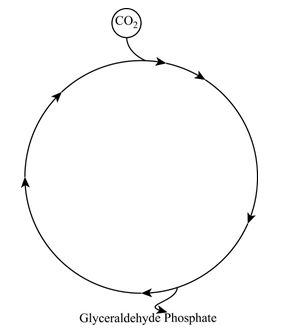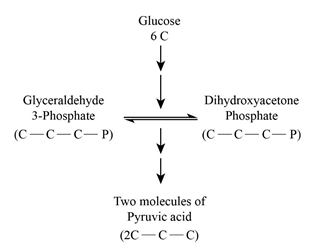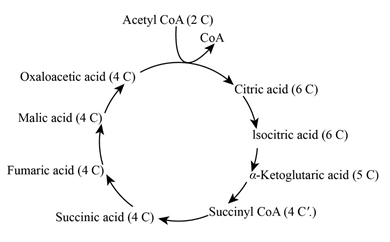
Concept explainers
To name:
The pathways diagrammed in parts (a), (b), and (c) of the given figure.
Introduction:
Cellular mechanisms involved in many reactions in which the transfer of electrons from one molecule to another take place by means of
Explanation of Solution
- The given diagram is the Calvin-Benson cycle. In this cycle, three molecules of carbon dioxide are fixed and one molecule of glyceraldehyde 3-phosphate is produced. After that, it leaves the cycle is shown in the below diagram.
- The given b diagram resembles the Glycolysis pathway. In this pathway, the oxidation of glucose yields two molecules of pyruvic acid as its end product.
- The below-given diagram is the Kreb’s cycle. Here, the decarboxylation of pyruvic acid produces one carbon dioxide molecule and one acetyl group.



To review:
The anabolic and catabolic mechanisms in the given pathways.
Introduction:
The cellular mechanism of all living organisms requires the energy for its
Explanation of Solution
Glycolysis and the Citric acid cycle are the major pathways for anabolic and catabolic mechanisms of all organic molecules, such as carbohydrates, lipids, and proteins. Glycerol is catabolized as Dihydroxyacetone phosphate in the Glycolysis pathway (a) and fatty acids are catabolized as acetyl CoA int he TCA cycle (b).
Glutamic acid is catabolized in the Krebs cycle (c). Glutamic acid is an amino acid which is catabolized by Kreb’s cycle at α-ketoglutaric acid which is formed from isocitric acid.
In the Calvin-Benson cycle, Glyceraldehyde 3-phosphate is the end product, which enters into glycolysis. In glycolysis, the glucose is oxidized into pyruvate which is decarboxylated to acetyl group and entered into the Kreb’s cycle.
The Calvin cycle requires 18 molecules of ATP between glucose and glyceraldehyde 3- phosphate.
Three molecules of carbon dioxide (CO2) is released in the Kreb’s cycle,
- Between pyruvate to acetyl CoA.
- Between isocitric acid to α-ketoglutarate (TCA cycle).
- Between α-ketoglutarate to succinyl CoA.
The long chain hydrocarbon like such as acetyl group is catabolized in the TCA cycle at acetyl CoA. This acetyl group like hydrocarbons are catabolized by beta-oxidation which enters into the Kreb’s cycle.
The production of NADH, FADH2 or NADH in glycolysis, Calvin-Benson and TCA cycles are,
The anabolic and catabolic pathways are integrated between,
- In glycolysis, the anabolic and catabolic pathways integrated into dihydroxyacetone phosphate.
- In the TCA cycle, the anabolic and catabolic pathways integrated into acetyl, oxaloacetic acid and ketoglutaric acid.
| Utilizes | Produces | |
| Glycolysis | 2 NADH | |
| Calvin-Benson cycle | 6 NADPH | |
| Pyruvate to acetyl CoA | 1 NADH | |
| Isocitrate to α-ketoglutaric acid | 1 NADH | |
| α-keto-glutaric to succinyl CoA | 1 NADH | |
| Succinate to fumarate | 1 FADH2 | |
| Malate to oxalate | 1 NADH |
Want to see more full solutions like this?
Chapter 5 Solutions
EBK MICROBIOLOGY
- Give examples of fat soluble and non-fat soluble hormonesarrow_forwardJust click view full document and register so you can see the whole document. how do i access this. following from the previous question; https://www.bartleby.com/questions-and-answers/hi-hi-with-this-unit-assessment-psy4406-tp4-report-assessment-material-case-stydu-ms-alecia-moore.-o/5e09906a-5101-4297-a8f7-49449b0bb5a7. on Google this image comes up and i have signed/ payed for the service and unable to access the full document. are you able to copy and past to this response. please see the screenshot from google page. unfortunality its not allowing me attch the image can you please show me the mathmetic calculation/ workout for the reult sectionarrow_forwardIn tabular form, differentiate between reversible and irreversible cell injury.arrow_forward
- 1.)What cross will result in half homozygous dominant offspring and half heterozygous offspring? 2.) What cross will result in all heterozygous offspring?arrow_forward1.Steroids like testosterone and estrogen are nonpolar and large (~18 carbons). Steroids diffuse through membranes without transporters. Compare and contrast the remaining substances and circle the three substances that can diffuse through a membrane the fastest, without a transporter. Put a square around the other substance that can also diffuse through a membrane (1000x slower but also without a transporter). Molecule Steroid H+ CO₂ Glucose (C6H12O6) H₂O Na+ N₂ Size (Small/Big) Big Nonpolar/Polar/ Nonpolar lonizedarrow_forwardwhat are the answer from the bookarrow_forward
- what is lung cancer why plants removes liquid water intead water vapoursarrow_forward*Example 2: Tracing the path of an autosomal dominant trait Trait: Neurofibromatosis Forms of the trait: The dominant form is neurofibromatosis, caused by the production of an abnormal form of the protein neurofibromin. Affected individuals show spots of abnormal skin pigmentation and non-cancerous tumors that can interfere with the nervous system and cause blindness. Some tumors can convert to a cancerous form. i The recessive form is a normal protein - in other words, no neurofibromatosis.moovi A typical pedigree for a family that carries neurofibromatosis is shown below. Note that carriers are not indicated with half-colored shapes in this chart. Use the letter "N" to indicate the dominant neurofibromatosis allele, and the letter "n" for the normal allele. Nn nn nn 2 nn Nn A 3 N-arrow_forwardI want to be a super nutrition guy what u guys like recommend mearrow_forward
 Human Heredity: Principles and Issues (MindTap Co...BiologyISBN:9781305251052Author:Michael CummingsPublisher:Cengage Learning
Human Heredity: Principles and Issues (MindTap Co...BiologyISBN:9781305251052Author:Michael CummingsPublisher:Cengage Learning Concepts of BiologyBiologyISBN:9781938168116Author:Samantha Fowler, Rebecca Roush, James WisePublisher:OpenStax College
Concepts of BiologyBiologyISBN:9781938168116Author:Samantha Fowler, Rebecca Roush, James WisePublisher:OpenStax College





